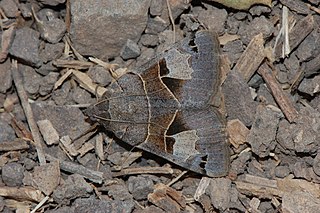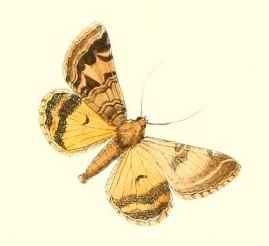
Hippophae is the genus of sea buckthorns, deciduous shrubs in the family Elaeagnaceae. The name sea buckthorn may be hyphenated to avoid confusion with the unrelated true buckthorns. It is also referred to as sandthorn, sallowthorn, or seaberry. It produces orange-yellow berries, which have been used over centuries as food, traditional medicine, and skin treatment in Mongolia, Ladakh, Russia, Ukraine, and northern Europe, which are its origin regions.

Hyles hippophaes, the seathorn hawk-moth, is a species of moth in the family Sphingidae. The species was first described by Eugenius Johann Christoph Esper in 1789.

Drasteria is a genus of moths in the family Erebidae.

Drasteria cailino is a moth of the family Erebidae first described by Alexandre Louis Lefèbvre de Cérisy in 1827. It is found in southern Europe, the Near East and Middle East up to the western Himalayas in the east. In the Levant, several isolated populations are present in Lebanon, Syria and Israel.

Drasteria adumbrata, the shadowy arches, is a moth of the family Erebidae. The species was first described by Hans Hermann Behr in 1870. It is found from coast to coast in southern Canada, south in the west to California and Colorado, south in the east to New England and Michigan. Subspecies D. a. alleni is found from eastern Alberta to New York and Nova Scotia. Subspecies D. a. saxea occurs from southern British Columbia and south-west Alberta south to California and Colorado.

Drasteria edwardsii is a moth of the family Erebidae. It is found from Washington, through Oregon to California.

Sterrhopterix fusca is a moth of the Psychidae family. It is found from England through central Europe, east to Russia, north to Fennoscandia, the Baltic States and Karelia. The southern limit of its range ranges from northern Italy to Romania.

Pseudotelphusa paripunctella is a moth of the family Gelechiidae. It is found from most of Europe to Siberia and the Caucasus.
Drasteria aberrans is a moth of the family Erebidae. It is found in central Asia.
Drasteria yerburyi is a moth of the family Erebidae. It is found in Somalia, Eritrea, the United Arab Emirates, Yemen and Iran.
Drasteria rada is a moth of the family Erebidae. It is found in Ukraine, southern Russia, Kazakhstan, Turkey, Georgia, Armenia, Iran, Kyrgyzstan, Mongolia and China.
Drasteria axuana is a moth of the family Erebidae. It is found in Mongolia, China and north-western Pakistan.
Drasteria catocalis is a moth of the family Erebidae. It is found in Kyrghyzstan, Kazakhstan, Tajikistan, China, Uzbekistan and Russia.
Drasteria chinensis is a moth of the family Erebidae. It is found in Kyrgyzstan, Kazakhstan, Mongolia and China (Gansu).

Drasteria langi is a moth of the family Erebidae. It is found in Afghanistan, Kyrghyzstan, Kazakhstan and Tajikistan.
Drasteria nephelostola is a moth of the family Erebidae. It is found in India.

Drasteria pulverosa is a moth of the family Erebidae. It is found in Russia and Mongolia.

Drasteria picta is a moth of the family Erebidae first described by Hugo Theodor Christoph in 1877. It is found in Ukraine, Russia, Kazakhstan, southern Turkey, Syria, Armenia, Daghestan, Kyrgyzstan, Uzbekistan, Turkmenistan, Mongolia and China.
Drasteria pictoides is a moth of the family Erebidae. It is found in Syria and the southern Caucasus.

Drasteria sesquistria is a moth of the family Erebidae. It is found in Russia, Kazakhstan, Afghanistan, Uzbekistan, Tajikistan, Kyrgyzstan, Turkmenistan and Mongolia.











